How Spore was created: interviews with developers
- Transfer
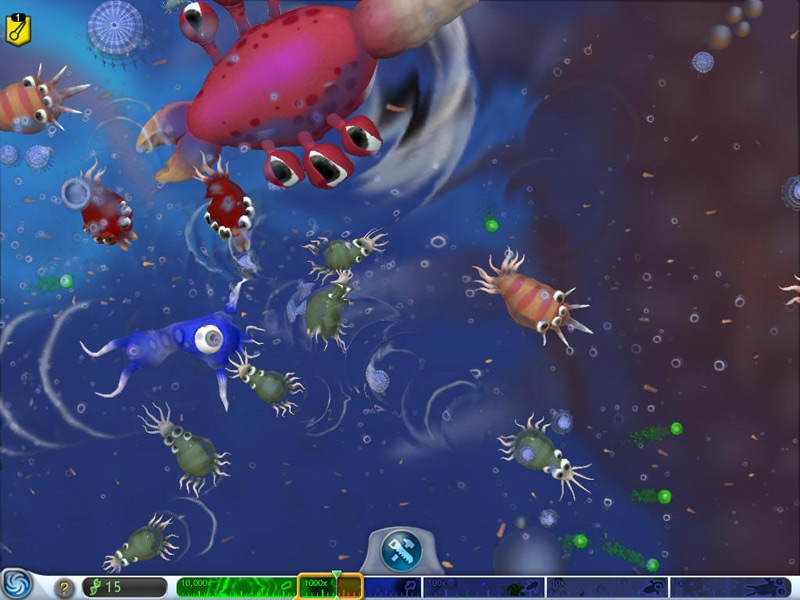
September 7, 2008 Maxis released one of the most ambitious games of its time - Spore .
The single-player “god game” in the sandbox was initially perceived with a mixture of approval and criticism: many fans were upset that it did not meet the expectations given in the demo versions of Will Wright’s GDC 2005 report and various E3 shows. But over time, it was recognized as a project that has become a pioneer of procedural generation, which even after ten years has an active player base.
During the development process, the Maxis team has grown from the idea in Will Wright's head to more than 100 developers; every designer who touched on certain aspects of Spore, knew it was something amazing. Even if the original concept will have to change during the work.
“When I first spoke to him, he wanted this game to be about the Drake equation . About the incredibility of our universe, ”says leading designer Chris Trotier on Skype. “He wanted the players to go through all these stages of huge failures, so that they understand how incredible that we have appeared. Pretty quickly, he abandoned this idea, but it makes it clear how large-scale the game was conceived from the very beginning. ”
Ten years later, participants in the project Sporewant to talk about the complexities, the important points and the experience of developing such an influential game. The article contains quotations from interviews conducted separately with lead designer Chris Trotje, technical artist Kate Compton, lead designer Stone Librande, software engineer Dave Quliba, lead gameplay engineer Dan Moskowitz and assistant producer Guillaume Pierre. (Unfortunately, Will Wright eludes us ... )
Team of independent thinkers

Stone Librande (Stone Librande, pictured): Working on Spore was exciting. Many participants in the industry today are doing the sequels of previous games: they simply take the finished game and add something new to it. Spore was so unique that we didn’t have many role models. Will had the idea of seeing “dozens of degrees,” when you start with a single cell, and then scale up to the level of galaxies. We thought "what?" This was not in any game before, so the whole team was very enthusiastic.
Chris Trottier: above SporeAn interesting team worked, because there were a hundred people in it who were used to thinking that they were the smartest in the room. When you communicate with people who are used to being great, it is very difficult for them to say: “I’m completely satisfied with what suits everyone else.”
We had a lot of people in love with their work who created the culture of debate. It was a kind of competitor team, people were eager to do their work to the maximum, which is good, great to have designers who love their work, but they are focused on local perfection and do not seek compromises that make up the game as a whole.
Dan Moskowitz:I worked for Sony for five years before joining Maxis. I developed games for the PlayStation 2, and until that point it was all my experience. As a student, I worked in a very cool research lab, and coming to Maxis was a bit like returning to it. When I first came to the company, there was an intern in it, all of whose work was to prototype weather patterns, and for an ordinary video game company this was unheard of. We had a man who worked on the optional part of the game, because we wanted the weather to be based on a real simulation.
This feeling of creating tools for creativity was an integral part of the Maxis culture, we liked more to do things that allow us to build any worlds we need.
Guillaume Pierre:when I first saw a design document in 2003, I thought, “Well, good luck with your work.” Part of the game resembled Pac-Man , part was similar to Diablo , another was like SimCity . I just did not believe that such a game would ever come out.

Blurred photo of the Spore development team in 2008 (courtesy of Guillaume Pierre)
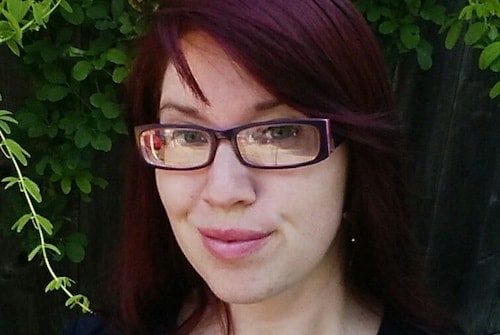
Kate Compton (Kate Compton, pictured): Will is a huge fan of astronomy, and the rest of the team had a diverse set of non-work related hobbies. People didn't just play video games as a hobby or job. We had people who loved biology and physics, the team had a former nurse - they just came with a bunch of ideas, and since this game was about everything, it could be anything. Therefore, we had a bunch of different prototypes, from a very complex simulation of oceanic particles to the Drake equation about the spread of life across galaxies.
We just had a lot of these things. There were always difficulties with the gameplay. We created a bunch of interesting situations, but it was necessary to put them together.
Dave Culyba: I had no experience before joining the Spore team . Therefore, one of the lessons for me was that creating games is a complex and often chaotic process. We did not have any one clearly outlined plan, it became a strong lesson: the scale of the game is so great that we have to figure it out for ourselves. The demo conveyed a good sense of what the game would be, but it hardly affected what the game should be. It was necessary to figure out what makes the different parts interesting, why we do this, and not this, how to put everything together, and how to make it all work.
Another interesting aspect was the assessment of the scale of the game in terms of the development schedule. We constantly had the feeling that the game was at the same time infinitely far from complete, and almost ready for release.
Innovation and vision - but what about the design of the game?
Pierre (pictured): Chris Hecker and Soren Johnson, who are now recording podcasts together, said that Will was more interested in creating a game studio and watching how different developers interact with each other as if it were a game. He hired a bunch of talented people based on their personality and characteristics, and wanted to see how they interact and make the game.
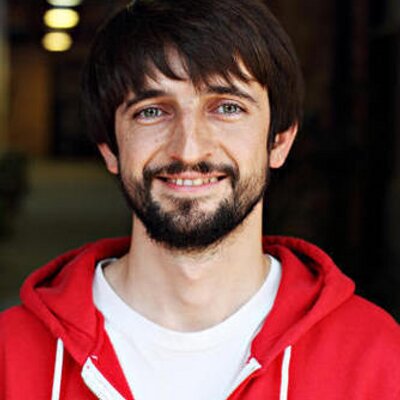
Librande:he had a very powerful vision, but behind this vision there was no strong game design. For example, we did not understand what a player should do from a game point of view. If you look at the creature editor outside the rest of the game, it’s just wonderful, it makes you smile. Even today it is a very interesting toy, and it is easy to understand why it is exciting. But when you start thinking about gaming systems from the point of view of the goals you need, how to give the player an increase in skills, which is the development of skills, and other aspects that are traditionally associated with games, there was simply no such thing.
Compton:it was surprising to see that procedural generation is used in such diverse aspects. In the skin generation system, throughout the generation of procedural meshes for the characters, the animation system of the multiplayer layers, and there were also whole procedural music systems - there were so many of them that we usually forgot that the musicians in their room also worked. We mutually cooperated with each other, and today, looking back at the entire set of tools used to generate procedural content, I can say that we used them all. For the generators of spaceships and creatures, we used completely different algorithms and tools.
I had the idea of creating variations of shared content. There must be something ordinary, something memorable, and something of a heroic level. Imagine that you have a landscape with many practically identical objects, maybe some of them are mathematically identical, for example, five identical types of trees with different rotation and scale. And there are a couple of eye-catching and memorable objects, for example, mountains. We need a "background" from different, but uninteresting objects, and super-interesting, memorable objects.
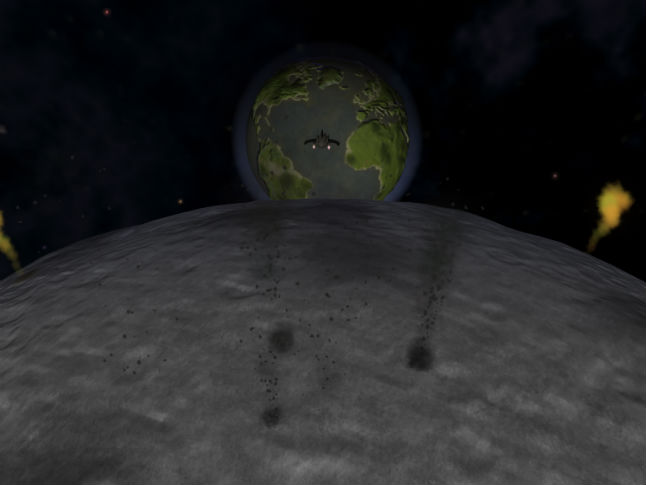
Planet Earth with a unique design, created by Compton.
For example, we had a good distribution of generating planets, but soon we began to see the same again and again. I inserted a pair of Easter eggs, for example, a cubic planet and an ideal model of the Earth, created according to the USGS . If you see them, they will surely be remembered.
Moskowitz: The coolest Spore technologyis a procedural animation system. This system controlled character animations in editors. She allowed to create a fully animated nine-creature, all of whose legs touch the ground and it moves naturally.
The system worked already in the process of creating characters, the editor reacted and played back animations, the creature could look at its own hand, smile or make a sound. What the player created immediately responded emotionally to him. If everything were static and the player created creatures, just to look at them, it would be much more boring. Each creature had a certain mouth and it produced certain sound effects, which created variability and tied the player to his creation. It was also a simple experiment - people tore off their legs, just to see what happens, saw the creature wriggle like a worm, and were in perfect ecstasy.

Trot (in the photo):the great thing was that all the prototypes and game modes started as talking, after which we continued to play and discuss. "And when does this happen?" Then what will happen when I see this and that? ”
I remember the prototype that we built based on the idea of the first contact - it was an interesting task, it was necessary to defeat the natives. It is always possible to simply wipe them off the face of the earth, but what if your goals change? What if you were first herbivores and were in a peaceful position, or you have species with lots of children, so this is a matriarchal society. And if you met another civilization obsessed with construction?
We threw five or six civilizations, and starting from scratch, tried to make the first contact with them all. We wanted to find out what the game is about, what we want to do to make it work for each of them. We have created many prototypes about crowd behavior, how to find out that they are scared or fascinated by a player, whether they will approach or run away, will shrink and consider the player to be their enemy, and also what needs to be done to change the situation.
It all came down to what we can actually implement in the game, to what was interesting. What types of gameplay will survive in these civilizations and what types of civilizations will survive. It was like matching your appetite with the size of your stomach. I want to eat everything, but will it fit so much in me?
Kuliba:interesting in the development of Spore was that the teams were divided in different ways. We had development teams of creatures, tribes, civilizations, space, and editors, but much more than it seemed at first, they were doing research. We did not have a clear idea about what kind of game we want to make, and much more suggestions and ideas about where we should develop. These were serious concepts that could come together to create something, and we had to deal with a lot of obscurity.
Librande:nobody forced us, just each had a lot of different work. We had a common technology, but each had its own approach and outlook on things. For example, that in a game about civilization, you can move and control armies on the entire planet, and in a game about creatures, a player is only on one island. The technology needed to implement RTS on a spinning ball is different from that needed for an island-like RPG game. Each team needed its own solutions to their problems and everything happened at the same time, therefore there was a lack of integration between the separate parts.
 Moskowitz (on photo):when working on the project, we constantly had a “rope pulling” between the player’s creative abilities and the game design of what the player had to do. For example, we wanted the game to have trees with fruits growing at different heights, and those players who created tall creatures had the opportunity to reach these fruits and become more developed.
Moskowitz (on photo):when working on the project, we constantly had a “rope pulling” between the player’s creative abilities and the game design of what the player had to do. For example, we wanted the game to have trees with fruits growing at different heights, and those players who created tall creatures had the opportunity to reach these fruits and become more developed. But there were all the limitations of the design, which did not allow players to create creatures of any height, this one had its own price. We were constantly deciding whether we needed to add more limiting design elements to the editor, or let the players do whatever they wanted to make the game more based on parameters. We wanted the player to be able to do anything with the creatures, and not just to add to the creatures the elements that determine the result.
Compton:Will Wright is a big fan of the old BattleBots show, in which people gathered robots who would then fight each other. It was the moment that killed the show - people realized that the top of the design of robots is a wedge-shaped robot, similar to the increased support for the door. He is very boring and cannot be defeated, he just endures other, more interesting robots.
If in Spore we decided to go through hard Darwinism and the survival of the fittest, when the player would have to create something that survives in this world, then we would get just a bunch of analogues of these wedge-shaped bots. We did not want to tell the player that all these strange, outlandish, wonderful creatures coming out of the editor are just bad and unfit for the world.
Pierre:we always had consequences. For example, if you do something in a game at the level of the cell, then this may affect the game with the tribe or the game in space. We had to figure out what effect different elements should have. It was necessary to maintain the importance of the elements, while not allowing the game to be exploited.
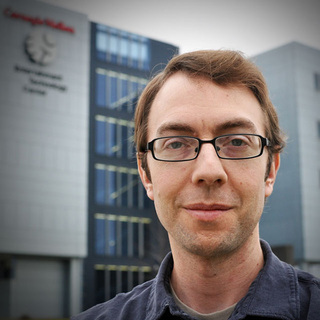
Dave Kuliba Trotye
: Strange situations often arose when the design team said it was necessary to reduce the volume. The game continued to evolve, and we wanted to provide it with an exponential complexity, to make every little thing important as the species became more and more complex. But we were limited in what we could do.
The controversy ended with the fact that we reduced the number of interesting aspects in order to give all of them significance. And this happened not only at the stage of the game of creatures, but also throughout their development as civilizations. It was necessary to invent examples of how different elements remained significant throughout all the games. If we added claws to the game, the creatures could have a different fighting style at the tribal level, and so on. We could imagine how the element changes from level to level, but in the end we did not have ten years to complete the project, and we had to take into account the budget. We had to choose elements that resonate at most levels, and of course, at times it was difficult.
Loss of connection with game design
Librande: after completing the game with cells, I switched to playing with creatures, and then we began to have conversations about the fact that these games are not particularly well combined. They were created in different teams, and the links between different games were weak, sometimes nobody even thought about them.
We were provided with another additional year of development just to work on this problem, to link all the games in one plot. Most people are not aware of this, but when you play Sporeseveral times, you get different space races with different characteristics. If during different games you play very aggressively, then as a result you will get a very aggressive race with great military power. But if in the beginning you play very peacefully, if you are a vegetarian, then when you get into space, you become a “shaman” - you can terraform planets and add trees. Most of the people with whom we spoke did not realize these branching paths of development, and this was what we needed to do first of all, instead of creating all these separate games.
We considered the results of games in three main cases: aggressive, passive, and a mixture of both. We took the output of each of these games and passed them to the next level. So when we got to space, we got the story of how we played.
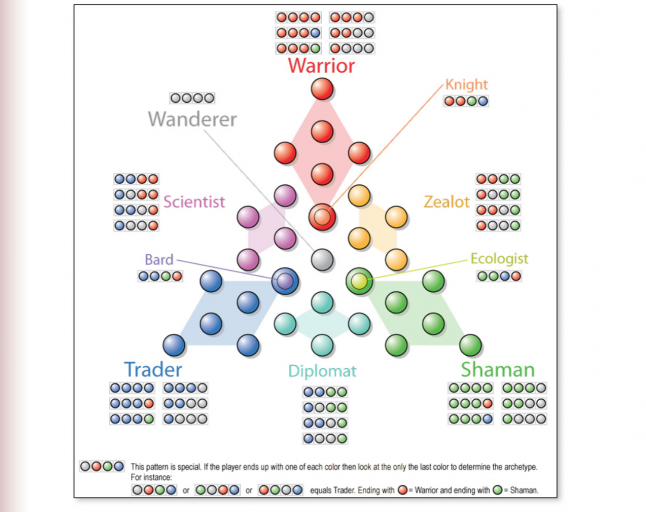
The last of many iterations to create a system of branching paths for the development of Spore (illustration provided by Stone Librande)
Instead of trying to determine the results of each individual combination, we decided to create a formula that simply gives us the answer. The player starts from the gray point in the center, and if he goes one way, he will become a shaman, if the other a warrior, if the third, then a trader. The layout of this space was quite a challenge, because it is huge and has many features.
Kuliba: from a certain point of view, it seems that SporeFor six years, it has been in preparation for production, and all this time we have been trying to figure out what the game will actually be; that it was not a well-thought-out project, in which we just had to sort out the colors. Innovation is needed in the gaming industry, but there is a lot of risk and uncertainty associated with it. Spore tried to be much more innovative than people thought. If you look at the original sentence, then Will talked about the different modes in the terminology of classic games. The idea that the game would use well-known gameplay was reassuring, but when you play Spore in reality, you don't think about Pac-Man , Diablo, or Civilization. The gameplay had to be different from the sources of his inspiration, thereforeSpore turned out to be more innovative than the gameplay.
Atlantis
Libranda: after the release of the game, there is always a moment when you expect how much the perception of the game will be in line with your expectations. I believed that this game would have a very long history, and even if after the release the reaction was not so strong, then I would have the feeling "well, let's wait another ten years, and then we'll see." Spore actually proved that it always remains relevant.
Compton: I can compare this game with a dandelion or the city of Atlantis. If you recall the myth, the greatest scientists of the world gathered in Atlantis, they built pyramids, created lasers and possessed alien technology. The city sank and everyone left it on the ships. Each ship went to its own continent, where development continued. I think this is exactly what happened with Spore., and therefore it is so important that Spore stopped development, and its ideas spread everywhere. The Maxoids (former Maxis employees) from the Spore project are now working for Oculus, Tilt Brush, Riot, Valve and dozens of indie projects. Some of us teach: dandelion cannot create new dandelions without spreading its seeds to the wind. The same thing happened with Spore .
